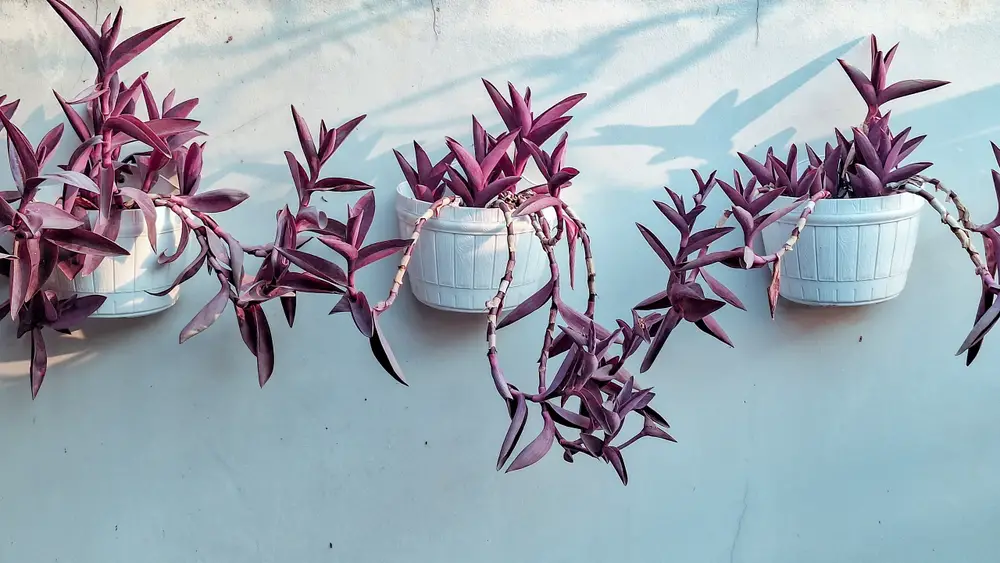Now, describing a color can be a bit of a challenge. One person’s “red” is another person’s “orange.” So when I say “purple houseplants” I mean ones with a dark color in their leaves. Think dark red wine, purple grapes, and sometimes almost black. Brighter colors, like fuchsia or bubblegum pink, I think of as pink plants.
I especially like purple plants. Their leaves have interesting shapes, they add color to the home and some of them have flowers that contrast beautifully with their dark foliage (although it’s sometimes tricky to get them to flower).
Here, I’ll give you detailed advice on the requirements of each plant to help you know if it’s the right one for you.
Choosing The Right Plant For Your Space
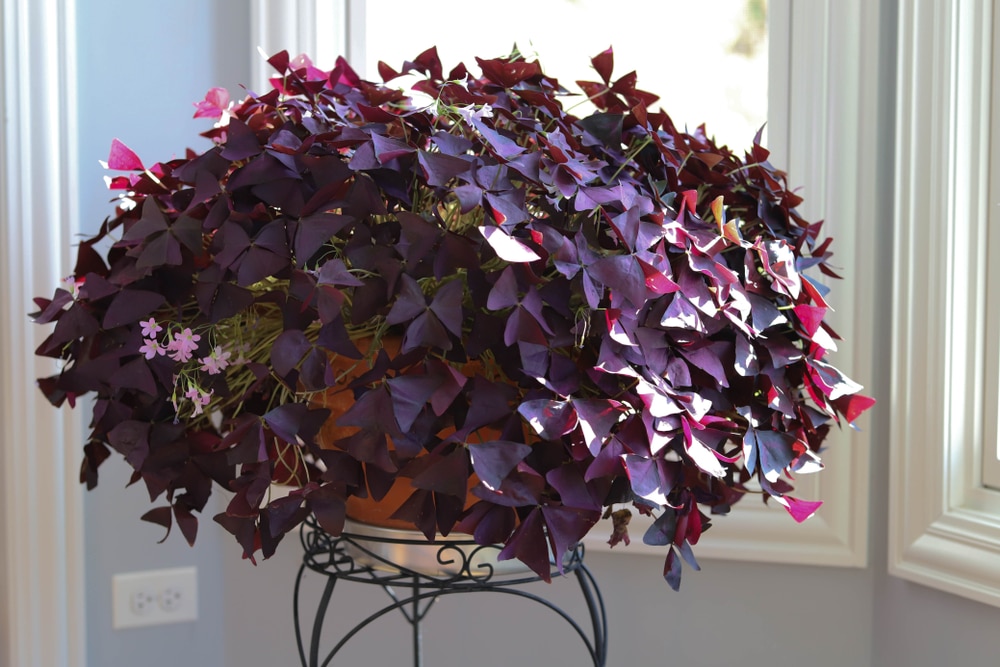
Get to know the specific needs of each of your plants. Every plant has different needs. Some like low light conditions, others need lots of sun. Some are good in small spaces, others can eventually grow quite large and take up a lot of space. Certain ones need lots of water, others not so much.
Like Goldilocks and her porridge, for plants to be happy and thrive all conditions need to be juuuuust right!
So, when choosing purple plants, always remember to match the needs of the plant to the location you want to put it in.
Please see the detailed information tables below for the requirements and guidelines for each specific plant.
Decorating With Purple Houseplants
Most people have at least one plant in their home. Their flowers add color and sometimes fragrance to a room. Some have colorful foliage in shades of pink, purple or green-blue that can liven up a space.
Purple plants add unique color and shapes to a home’s decor when placed in just the right spot.
These plants generally have a more subdued look but can go well with just about any decor.
The dramatic foliage suits a modern interior design aesthetic. They work particularly well when styled in monochromatic rooms. Place a Persian shield plant against a stark white wall for a striking effect.
Consider pairing purple plants with bright green plants for a vibrant contrast. Or pair with pink plants for pops of color.
Purple plants are great for an office setting too. Most office spaces have low-light conditions from a plant’s point of view, though, so you need to be more selective when choosing plants for an office space.
Safety Considerations For Pets And Children
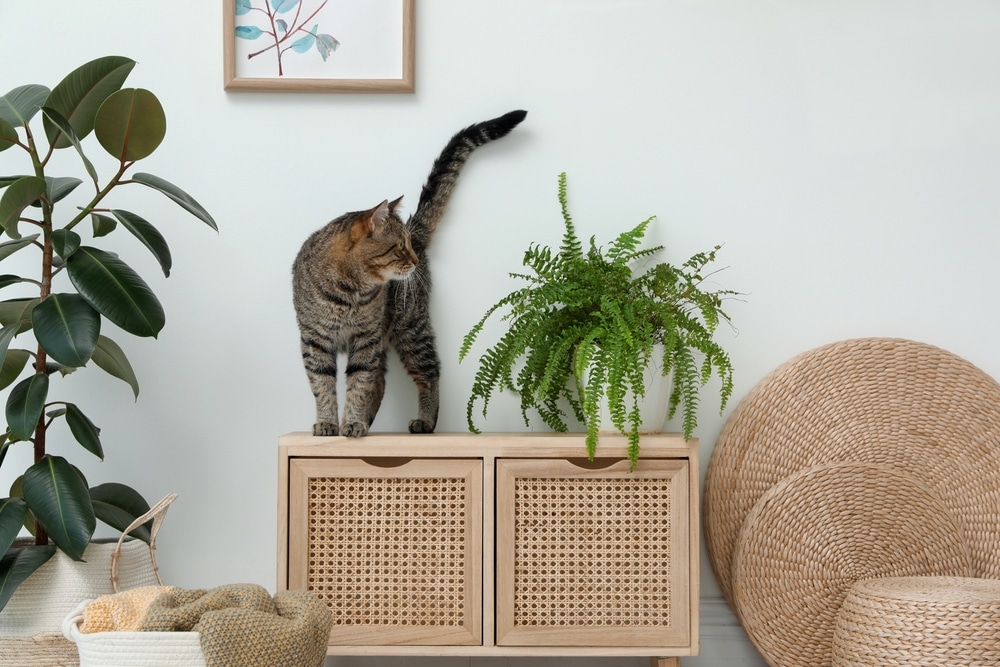
At Gardenia Organic, we strive to provide helpful information on a variety of plants and their benefits. When incorporating any plants into your home, it’s important to consider the safety of your pets, as some plants can be toxic if ingested.
For the health of your pets (and plants!), we suggest locating your houseplants in locations that are less accessible to curious animals.
While we offer guidance and information, we encourage you to research each plant’s safety so you can make informed decisions. Always monitor your pets around houseplants, take precautions to ensure their well-being, and consult with a veterinarian if you have any concerns.
Naturally, the same cautions apply in homes with small children, who are often drawn to the colors and shapes of houseplants. Keep plants out of reach of curious little hands. If you’re unsure about having plants in your home, consult your family doctor.
Your family’s safety is our priority, so do some research and educate yourself about each plant’s possible risks. Then you can enjoy your indoor greenery while keeping your children and pets safe and happy.
Common Problems And Solutions For Purple Plants
Indoor plants of all sorts suffer from common challenges. Some are caused by environmental conditions (e.g. dry air, low light, too much water, not enough nutrients). Others are the result of insect pests or disease.
Here are some trouble-shooting tips for the most common issues you might encounter to keep your plants healthy and thriving.
Droopy-looking Leaves
The most common mistakes with indoor plants come with watering: too much or too little.
When the soil is allowed to dry out, there’s not enough water for a plant to take up. A plant’s leaves slowly go dry and look wilted. The lower leaves will wilt first.
On the other hand, if there’s too much water in the soil, the roots can’t function and the plant can’t take up the water it needs. The leaves start to look droopy and wilted but won’t feel dried out.
In other words, over-watering can be just as damaging as not watering enough. More than one indoor plant has been killed with watering kindness!
What To Do
If the leaves on your plant are droopy, check the soil. If it feels moist, allow the soil to dry out to allow the roots to recover.
Always check the moisture in the soil before watering. For most plants, if the top 1 inch (2.5 centimeters) is dry, then you can add water. But be sure to get to know the exact needs of each variety you own. Some like to have the soil dry out completely in the pot before watering again, while others like their soil consistently moist.
Leaves With Dry Brown Tips And Edges
Crispy brown leaf tips are common. It’s often a sign that the air or soil – or both – is too dry for the plant’s liking. But it could also be a symptom of a fertilizer problem.
Conditions Too Dry
Most houseplants are native to warm and humid tropical areas. Our winter home heating can make the air very dry which is a challenge for these plants.
Be sure not to place yours near a winter heat source like a baseboard heater, wood stove, or heat pump.
Also don’t put them in the path of air conditioner vents. Cold air can dry out plants too. If the air is cold enough it even causes internal damage to plant cells.
What To Do
To increase the humidity around your plants, use a spray bottle on the mist setting and mist in winter. How often will depend on the type of plant.
Or you can sit the houseplant in a saucer filled with stones and water. Be sure the bottom of the pot sits over – and not in – the water. Keep the water level topped up.
Too Much Fertilizer
Another possible cause of yellowing and dead brown leaf tips is too much fertilizer. Too much fertilizer is worse for plants than too little. The salts in the fertilizers can burn the leaves when too much is applied all at once.
If the leaves suddenly show these symptoms a week to ten days after you’ve fertilized your plants, then you may have overdone it. Fertilizers can also build up to harmful levels in the potting soil over time.
What To Do
When using water-soluble fertilizers, it’s better to mix half the concentration suggested on the label and use it twice as often.
Leaves Are Turning Yellow
There are several reasons leaves turn yellow. You can often get a clue to the problem by considering where the yellowing leaves appear on the plant.
Are one or two older leaves towards the bottom gradually turning yellow? Or are leaves all over the plant turning yellow? Are leaves turning yellow only on the sunny side of the plant?
Bottom Leaves Turning Yellow
Sometimes an older plant will naturally drop its older leaves at the base of the plant as new growth continues at the top. But sometimes there’s something else going on.
Fertilizer
When one or two of the older leaves at the base of the plant slowly turn pale green then yellow, and at the same time there’s lots of healthy new growth at the top of the plant, the trouble may be a nutrient deficiency in the soil.
Nitrogen (the N – or first number – on a fertilizer package) is a key component in chlorophyll, the substance that makes leaves green. Without enough nitrogen available, leaves all over the plant will slowly go pale and turn yellow. The plant will eventually stop putting on new growth.
When there isn’t enough nitrogen available in the soil, and a plant is putting on new growth, it will transfer nitrogen from the older leaves at the bottom up into the tips of the plant to support the new growth.
You may need to repot your plant with fresh soil that can provide some nutrients. In addition, you should apply a houseplant fertilizer to provide some nitrogen.
Leaves All Over The Plant Turning Yellow
Watering
A common cause of yellowing leaves is how we water our plants; overwatering or underwatering.
If some leaves are turning yellow then dry out and fall off, the culprit is likely underwatering. If the leaves just turn yellow and droopy, then overwatering is probably to blame.
Purple leaf plants will lose their color and look washed-out, or turn pale yellow or even creamy white, rather than the deeper yellow in with green leaves.
Before watering, always check the soil in the pot.
Lighting
If leaves all over the plant start turning pale yellow but not droopy, the problem is probably lack of light. Purple leaf plants lose their rich color and look washed out if they don’t get the light they need.
Leaves Turning Yellow On One Side of The Plant
Indoor plants usually get light on one side at a time; the side facing the window. When a plant gets more sun that it likes, its leaves will turn pale yellow.
So, if the leaves on the side that face the window are turning pale but the shadier side of the plant is fine, then the plant is probably getting too much sun.
They’re literally getting a sunburn and the plant needs to be moved to another spot with less intense light.
Where to Buy Houseplants
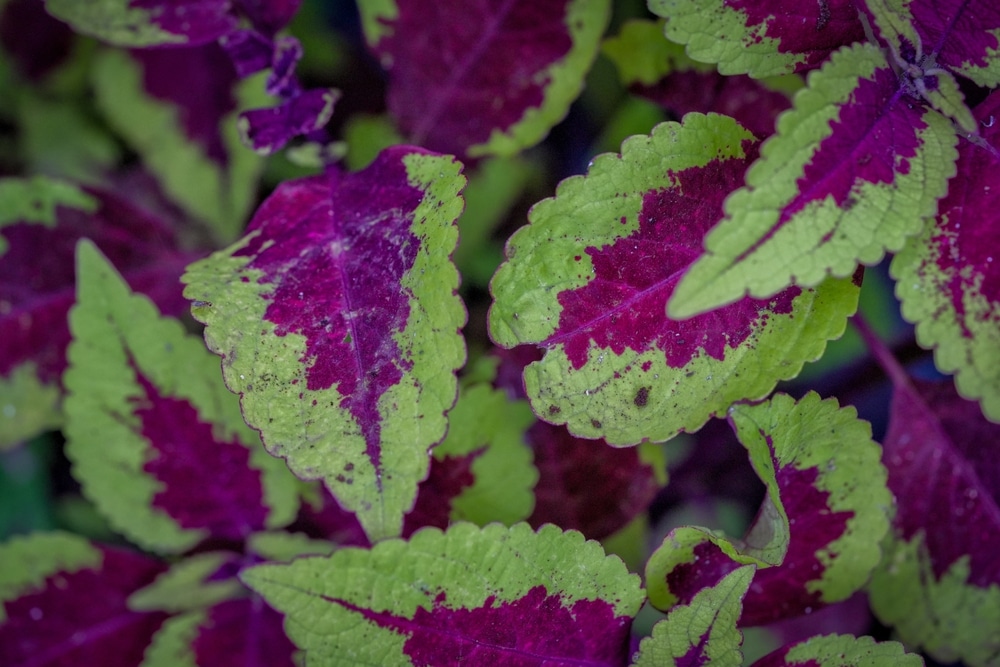
There are lots of places you can go to find them. Garden centers and florists would be my first stop, and then grocery stores. You can also find them in the garden centers of hardware stores and “big box” stores.
You can also buy online, but I prefer to buy mine in person. This is because at garden centers and florists you can find someone to talk to who’s knowledgeable about plants and who can answer questions you might have. You can also examine the plants before you buy them (see tips below).
When you shop online, you don’t really know what you might be getting. Plus, shipping can put a lot of stress on a plant, so you don’t know what condition it will be in when it arrives on your doorstep.
Tips for Buying Houseplants
When shopping in person, it’s important to be sure the plant you’re buying is healthy and in good condition.
Here are some things that I recommend you look for:
Healthy Foliage
Look for leaves that are nice and green, no pale yellow patches or edges (unless the plant is supposed to be multi-coloured!) There should be no dead dry brown tips or spots on the leaves. Be sure the leaves aren’t soft and droopy-looking. Also look for healthy new growth coming in at the tips or base of the plant.
No Sign Of Pests
Check the leaves and stems closely for any sign of insect pests. Pick up the plant and see if any insects fly away (possibly thrips or soil gnats).
Look for very fine webbing on the underside of leaves and where the leaves attach to the stem (sign of spider mites).
Check for things that look like small dabs of cotton wool on the underside of leaves or where the leaves attach to the main stem (sign of mealybugs).
Roots Coming Out The Drain Holes
When a plant’s roots run out of room in a pot, the plant is rootbound (or “pot bound”).
Some plants grow just fine being slightly pot bound but most don’t. If you see roots poking out the drain holes in the bottom of the pot, it’s time for the plant to be re-potted into a larger container.
It doesn’t mean the plant is unhealthy, it just means you’ll have to be prepared to re-pot it when you get it home. Some garden centers offer this service.
Purple House Plants
Here’s my top 15 plants with interesting purple foliage. I’ve included comprehensive details on each plant’s requirements including:
- How to grow
- Light requirements
- Soil requirements
- Watering tips
- Pruning purple foliage plants
- Fertilizer needs
- Repotting advice
So, use this guide to help you choose the perfect purple indoor plant for your home!
1 – Purple Shamrock (Oxalis triangularis)
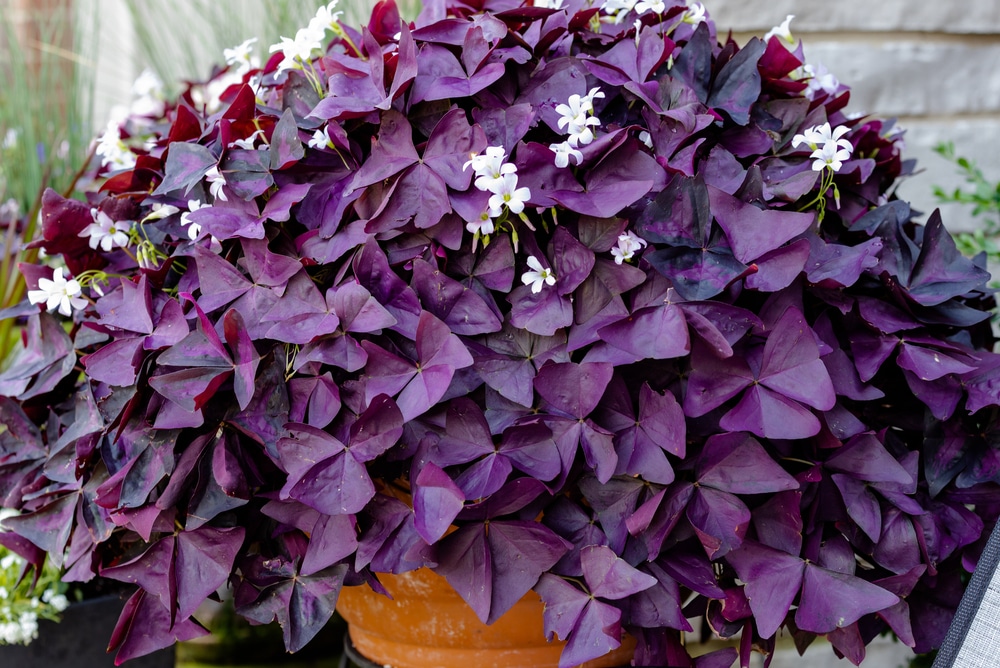
| Origin | South America |
| Plant size | Grows 6-12 inches (15-30 centimeters) tall and 12-24 inches (30-60 centimeters) wide |
| Flowering | Fall through spring |
| Light | Bright indirect sun |
| Watering | Keep soil evenly moist when flowering (fall through spring). Water when the top inch (2.5 centimeters) of soil has dried out. Reduce watering in summer when plants go dormant and stop flowering |
| Fertilizer | Apply general-purpose fertilizer, diluted to half the label recommendations, when the plant is in flower. Stop fertilizing when not in flower in summer |
| Potting soil | Sandy well-drained |
| Pruning | n/a |
| Repotting | Repot every 2-3 years |
| Toxicity | All parts of the plant are toxic to people and pets if ingested |
This is one of the few indoor plants with leaves that are a true dark purple, almost black-looking.
Each leaf has three triangular lobes, hence its name. It may look like a shamrock but isn’t one. At night – or in low light conditions – the leaves fold up and the plant looks sick. Don’t worry – they’ll open up again when daylight returns.
The plant produces small flowers in shades of pale pink, lavender purple or white. They flower in the lower-light conditions of fall through spring.
Note
In its native habitat of South America, purple shamrock goes dormant in the hot summer temperatures. So as an indoor plant, if the plant is in full sun and the indoor temperature goes above 80 F (27 C) the plant may go dormant.
The leaf stems will droop and leaves will slowly turn yellow and die off. Put the plant in cool low light conditions for about a month. When new shoots appear, put the plant back into high light conditions and resume watering.
2 – Rex Begonia (Begonia rex-cultorum)
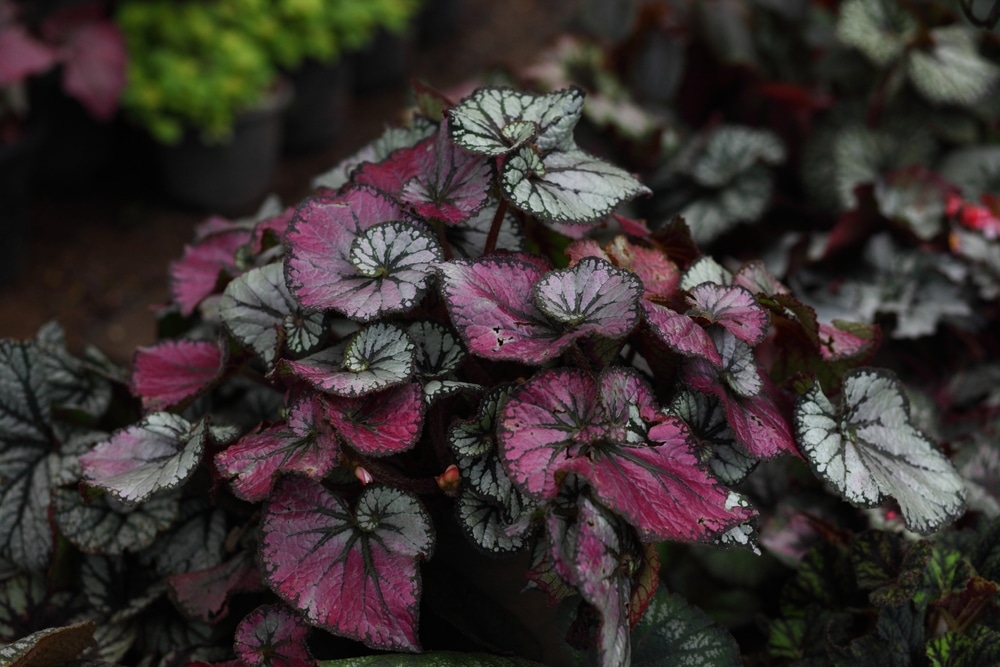
| Origin | Asia |
| Plant size | Grows up to 18 inches (45 centimeters) tall and wide |
| Flowering | Minimal |
| Light | Bright indirect light. Direct sun in winter is ok. Tolerates low light conditions (4 hours sun) |
| Watering | Keep soil consistently moist, not soggy. Allow the top inch (2.5 centimeters) to dry between waterings. Water sparingly in winter |
| Fertilizer | Apply high potash (K on the label) fertilizer every two weeks spring through fall. Do not fertilize in winter |
| Potting soil | General purpose potting mix |
| Pruning | n/a |
| Repotting | Repot in spring, when rhizome grows to the edge of the pot |
| Toxicity | Rhizome is most toxic part of plant. Leaves mildly toxic to people and pets if ingested |
One of the most popular indoor plants, the Rex begonia is also known as the painted-leaf begonia. Its hairy heart-shaped leaves are a blend of colors, ranging from dark green,red, pink, purple, to silver. They’re a great choice to add a dash of bright color to a low-light room.
Rex begonia is grown for its beautiful foliage and doesn’t produce many flowers. They like high humidity and are good choices for the low-light conditions in a bathroom.
To keep your Rex begonia a nice all-around even shape, turn the pot weekly so all sides of the plant get an even amount of light.
There are many varieties of begonia, and they fall into 3 groups, based on their type of root system:
- Fibrous
- Rhizomatous
- Tuberous
Each group requires slightly different care.
The Rex begonia is in the“rhizomatous” group. A rhizome is a type of plant stem but instead of being upright, it grows along the surface of the soil. growing roots down into the soil as it goes. Rhizomes grow roots down into the soil as well as growing shoots and leaves above the soil.
Rhizomatous begonias may lose all their leaves and go dormant over the winter. Put in a cool low-light spot for 6-8 weeks. When new growth appears, place the pot back into a sunny spot.
A Note on Repotting
When the Rex begonia rhizome reaches the edge of its pot, it’s time to repot your begonia to give the rhizome more room to grow. These begonias grow best in shallow but wide pots that give their rhizomes plenty of room to spread.
3 – Iron Cross Begonia (Begonia masoniana)
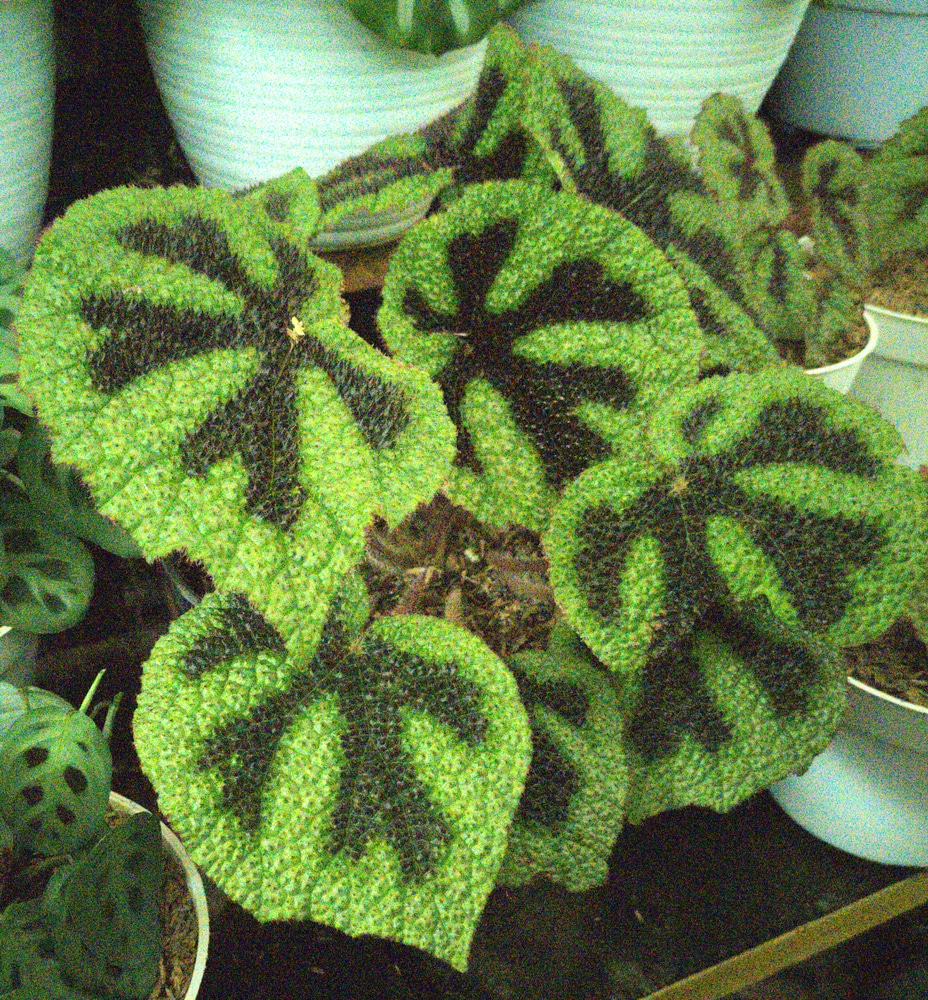
| Origin | Southeast Asia |
| Plant size | Up to 1 foot (30 centimeters) tall |
| Flowering | Spring and summer |
| Light | Bright indirect sun. Grows well under fluorescent plant lights |
| Watering | Water thoroughly and allow the top inch (2.5 centimeters) of soil to dry out between waterings. Reduce watering in winter. Avoid getting water on the leaves |
| Fertilizer | Apply balanced fertilizer diluted to half the recommended concentration once a month spring through fall. Do not fertilize in winter |
| Potting soil | All-purpose potting mix with additional perlite added for better drainage. Potting mix labeled for African violets |
| Pruning | If plants get tall and straggly, pinch back to just above a leaf to encourage more bush growth |
| Repotting | Repot in spring when new growth has started |
| Toxicity | Rhizome is most toxic part of plant. Leaves mildly toxic to people and pets if ingested |
Iron cross begonia is another rhizomatous-type begonia. The leaves are bright green, deeply puckered, and hairy. In the center of each leaf is a mahogany-purple – almost chocolate brown – cross pattern. The leaves are sometimes also edged in purple.
In spring and summer they may produce small clusters of pinkish-white flowers. But the flowers aren’t much of a show compared to the foliage.
Give it sufficient light and the leaves will have good intense colors. Too little light and the plant will be spindly (“leggy”) and not flower.
Begonias don’t like to be over-watered. A plant that gets too dry can be revived but an overwatered plant may suffer irreversible root damage. So make sure your begonia’s pot has good drainage so the soil doesn’t sit wet.
If your begonia starts to wither in the fall and the leaves die back, don’t worry. The plant hasn’t died completely, it’s just going dormant and having a rest for the winter. Stop watering it, cover the pot with a plastic bag to keep the soil from drying completely, and put the plant in a cool location. In about 6-8 weeks, you should see new shoots appear.
4 – Coleus (Plectranthus scutellarioides)
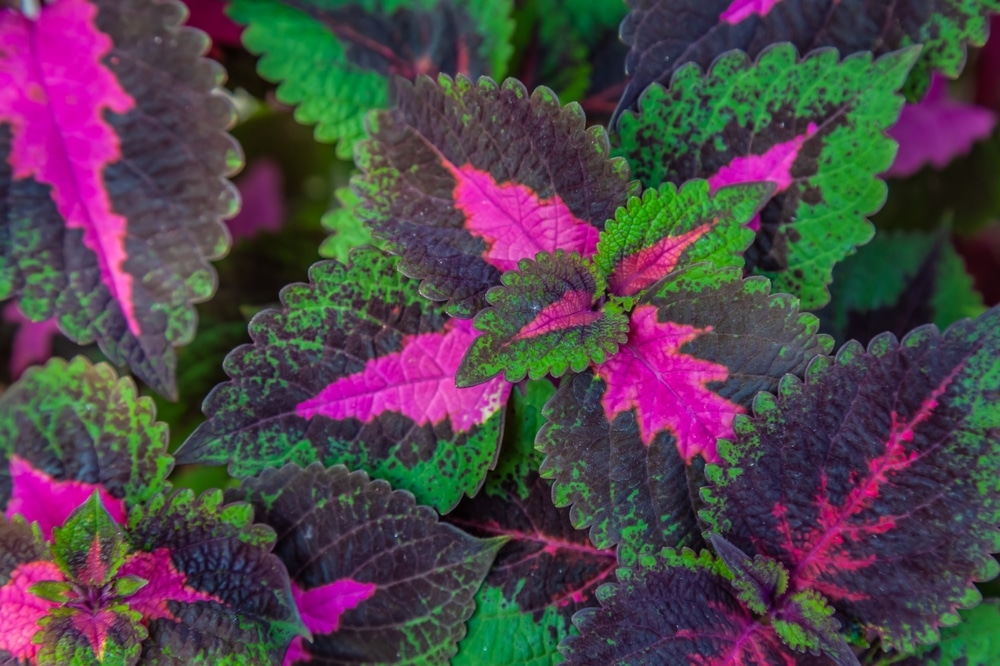
| Origin | Tropical Africa, Asia |
| Plant size | Grows to about 24 inches (60 centimeters) tall |
| Flowering | Generally does not flower as an indoor plant |
| Light | Bright indirect sun. Avoid strong direct sun. Direct morning sun only |
| Watering | Keep soil slightly moist, not wet. Do not allow to dry out completely |
| Fertilizer | Apply balanced fertilizer every two weeks spring through fall, diluting to half recommended strength. Stop fertilizing in winter |
| Potting soil | Soil-based potting mix |
| Pruning | Pinch off growing tips to encourage bushy side growth. If plants become tall and spindly, cut back a third to half of stem, just above a leaf node |
| Repotting | Repot as needed, spring to summer, when roots crowd the container. |
| Toxicity | Mildly toxic to people and pets if ingested |
Coleus plants are often grown outdoors as an annual in colder zones but they also make great indoor plants. There are several varieties, many with striking foliage in shades of green, bright yellow, pink, deep magenta, purple, and orange.
Grown outdoors, they will flower, set seed and then die. When grown inside, they don’t often flower but if they do, it’s important to pinch off any flowers that may appear. That way, the plant will continue to thrive.
Coleus can sometimes be short-lived. They can eventually grow tall and spindly, dropping leaves or growing smaller and smaller leaves. Then it will be time to think about replacing them or taking cuttings to start new plants.
5 – Purple Passion Plant or Purple Velvet Plant (Gynura aurantiaca)
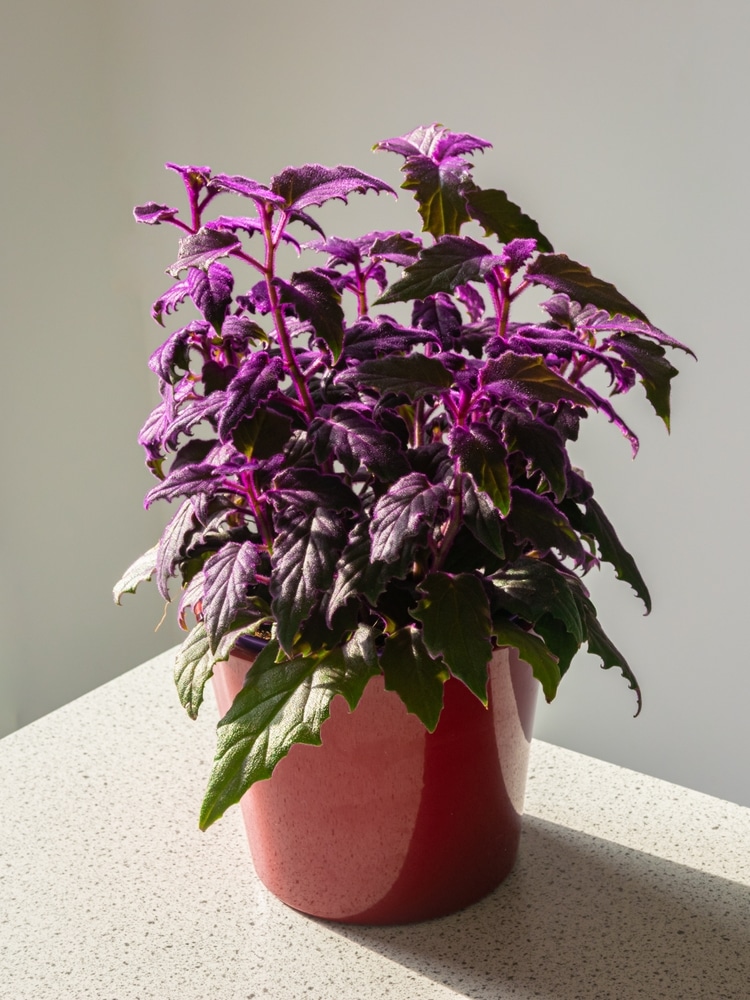
| Origin | Asia |
| Plant size | Trailing stems reach up to 5 feet (150 centimeters) long |
| Flowering | n/a |
| Light | Bright indirect sun for best leaf color. Non direct summer sun |
| Watering | Keep soil evenly moist but not soggy in spring and summer. Reduce watering in winter |
| Fertilizer | Apply balanced liquid fertilizer every two weeks in spring and summer |
| Potting soil | Peat moss-based mix, with added perlite or vermiculite for good drainage |
| Pruning | Pinch back growing tips to keep plants compact. Cut back to 6 inches (15 centimeters) in spring |
| Repotting | Can tolerate being root-bound. Repot in spring to slightly larger container |
| Toxicity | Considered non-toxic to people and pets |
The purple passion plant has deep green holly-shaped leaves with purple veins and edges. The stems are also a striking bright purple. This plant is also covered with purple hairs, giving it an overall purple velvet appearance.
It has a long trailing growth habit. It can be tied onto a trellis or left to trail down from its pot.
These plants are generally short-lived, and generally are replaced after 3-5 years. You can take cuttings and start new plants.
6 – Persian Shield or Royal Purple Plant (Strobilanthes dyerianus)
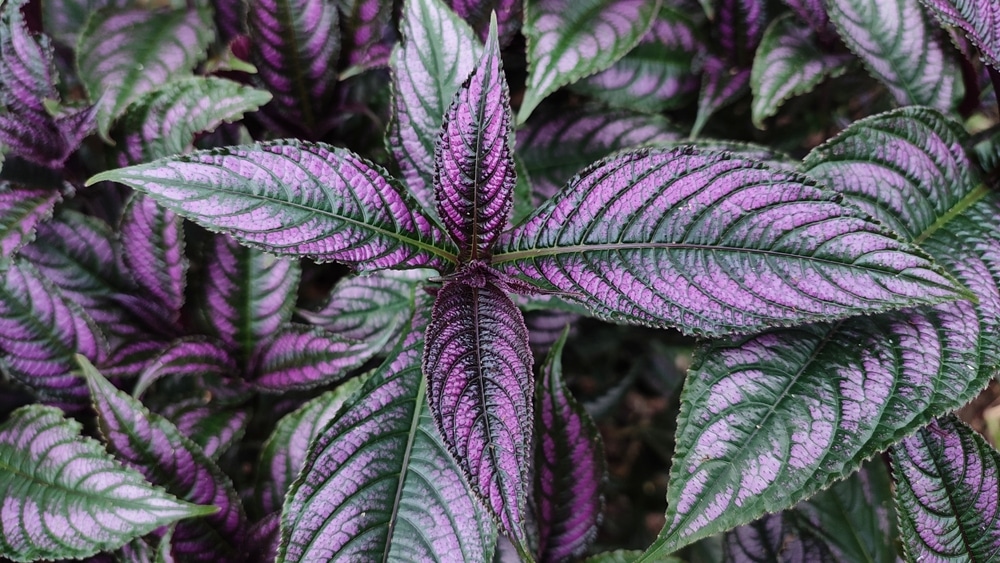
| Origin | Burma |
| Plant size | Grows up to 24 inches (60 centimeters) tall |
| Flowering | In winter |
| Light | Bright filtered light |
| Watering | Keep evenly moist. Allow the top 1-2 inches (2.5-5 centimeters) of soil to dry out between waterings. Water less during winter |
| Fertilizer | Apply balanced fertilizer every two weeks in summer |
| Potting soil | Soil-based mix with extra perlite added compost |
| Pruning | Pinch growing stems back at a leaf node to encourage bushier growth. If plant gets tall and leggy, cut stems back to a leaf node, about 4 inches (10 centimeters) above soil level |
| Repotting | Repot when roots fill the pot |
| Toxicity | Non-toxic to people and pets but may cause stomach upset if ingested |
Persian shield is a fast-growing upright plant with lance-shaped 6-inch (15 centimeters) leaves. It is grown for its intense-coloured foliage.
Its leaves have a silvery purple, almost metallic, surface with green veins and margins. The underside of the leaves is a deep purple. The purple coloring fades as the leaves age.
Persian shield likes humid conditions, or else the leaves may dry and drop off. Fill a large plant saucer with pebbles and add water, leaving some pebbles above the water line. Sit the plant pot on the pebbles with the pot over – not in – the water.
Unlike many indoor plants, Persian shield often flowers during the winter. Pinch off the spent flowers and leave the rest of the plant to go dormant until spring.
Because plants are fast-growing and older leaves tend to lose their vibrant coloring, Persian shield plants are often replaced after a year or two.
7 – Purple Heart Spiderwort (Tradescantia pallida or Setcreasea purpurea)
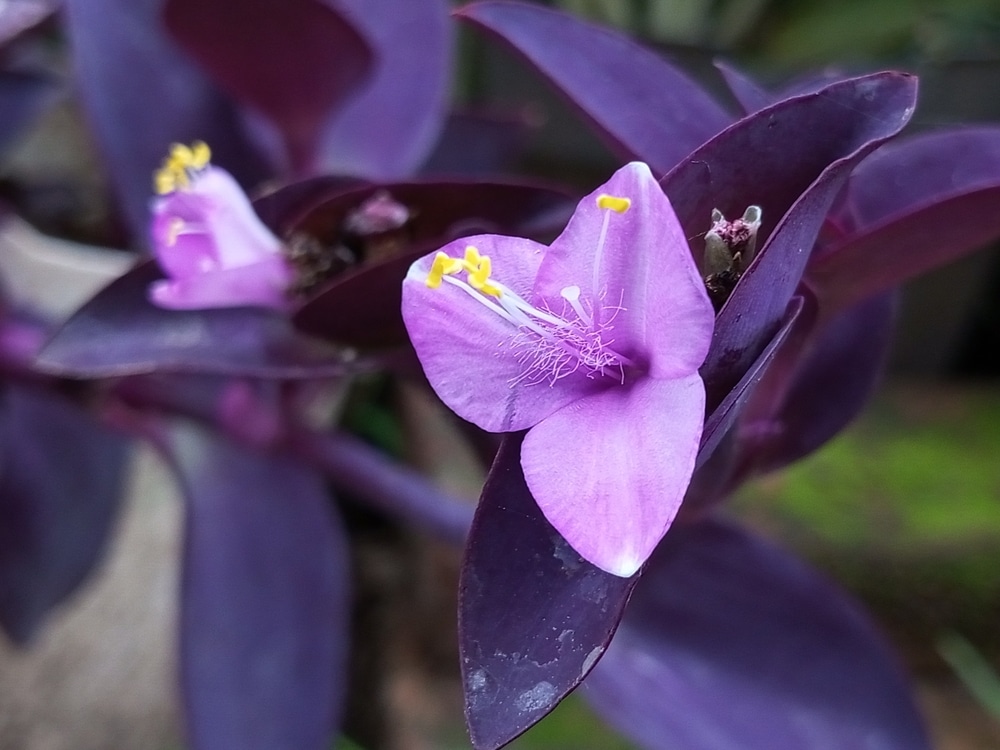
| Origin | Mexico |
| Plant size | Trail to about 24 inches (60 centimeters) |
| Flowering | Inconspicuous. Rarely flowers as an indoor plant |
| Light | Bright light with some direct sun but not in summer |
| Watering | Keep soil evenly moist. Allow soil surface to dry slightly between waterings |
| Fertilizer | Apply balanced liquid fertilizer every two weeks in summer |
| Potting soil | General all-purpose potting mix |
| Pruning | Pinch back tips at a leaf node to encourage bushy growth |
| Repotting | When roots show through pot’s drainage holes, repot into new container 1-2 inches (2.5-5 centimeters) wider |
| Toxicity | Toxic to pets and people when ingested in large quantities |
Purple spiderwort is one of the most common and popular plants for the home. It’s easy maintenance, and tough as nails. It will survive even if it doesn’t get the best of care. So it makes for a good beginner plant!
It is a trailing plant with succulent jointed stems where its lance-shaped leaves clasp around the stem. The leaves are solid rich deep purple and slightly hairy. They grow about 4 inches (10 centimeters) long and 1 inch (2.5 centimeters) wide.
The foliage has its best coloring when the plant is in bright sun.
In summer, the plant produces small bright pink flowers that contrast nicely with the deep purple foliage. The stems start upright and then arch over and trail down over the container. It’s a perfect plant for a hanging basket or placing on the top of a shelf to trail down.
The growing tips sometimes curve slightly upwards. The stems can be pruned to keep the plant shorter and denser.
8 – Silver Inch Plant, Zebra Plant, Wandering Dude (Tradescantia zebrina or Zebrina pendula)
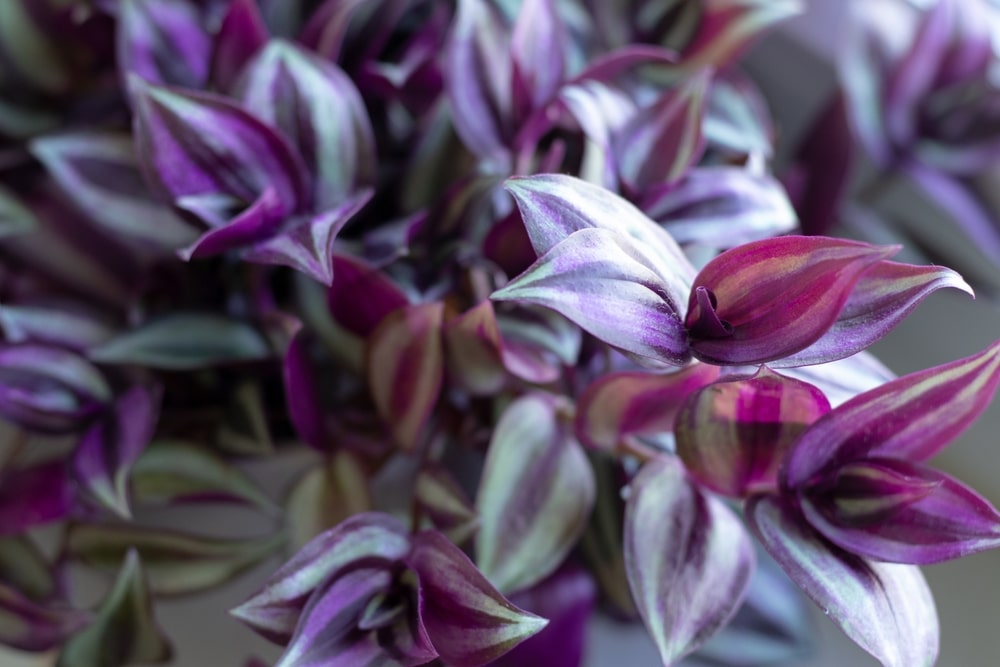
| Origin | Mexico |
| Plant size | About 9 inches (22 centimeters) tall, trailing to 3 feet (90 centimeters) |
| Flowering | Inconspicuous. Rarely flowers |
| Light | Bright indirect sun |
| Watering | Keep soil consistently moist but not wet. Water when the top inch (2.5 centimeters) of soil feels dry. Reduce watering in winter |
| Fertilizer | Apply balanced liquid fertilizer every 4-6 weeks spring through summer |
| Potting soil | General-purpose potting mix with a bit of added perlite for good drainage |
| Pruning | Pinch back stems as needed to maintain desired shape and size |
| Repotting | Repot every 1-2 years, when the plant has crowded its container. New container should only be slightly larger, about 1 inch (2.5 centimeters) bigger in diameter |
| Toxicity | Toxic to pets and people when ingested in large quantities |
Silver inch plant is very popular. It is easy care and has interesting coloring. It has succulent stems with purple and green leaves, striped with silver. The more natural lighting it gets (as opposed to indoor plant lights), the more purple – and less striped – the leaves will be.
It is a fast-growing plant and the stems can become long and straggly-looking. These can be cut back to encourage bushier growth. To fill in the pot, stick the cut stems directly into the potting soil to root.
9 – Purple Sweet Potato Vine (Ipomoea batatas)
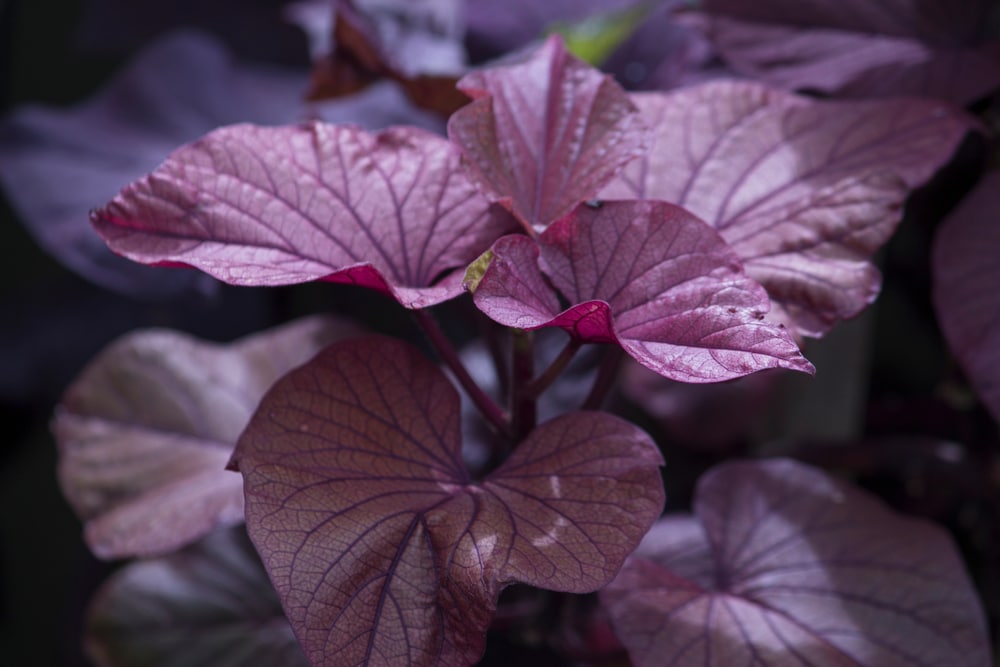
| Origin | Asia |
| Plant size | Vines |
| Flowering | Rarely when grown indoors |
| Light | Bright indirect light. |
| Watering | Keep soil evenly moist but not soggy |
| Fertilizer | Plants can tolerate low nutrient conditions. Apply balanced fertilizer during the active growing season (spring to fall). |
| Potting soil | General purpose potting mix with a bit of added perlite for good drainage |
| Pruning | Regularly cut back long vines just above a leaf node to encourage shorter bushier plants |
| Repotting | Repot in spring when roots crowd the pot |
| Toxicity | Not considered toxic to people but toxic to pets |
Purple sweet potato vine is a relative of the edible sweet potato, but this one isn’t particularly tasty!
There are several varieties, some with purple leaves, others with green leaves. Varieties with purple leaves include:
- ‘Blackie’
- ‘Midnight lace’
- ‘Sweetheart purple’
- ‘Sweet Caroline’
They are vigorous trailing plants, with heart-shaped leaves or more deeply divided maple-like leaves. The vining stems can grow quite long but a plant can be kept shorter and bushier with pruning.
Vines may be grown to trail down out of their pots. They can also be tied on a trellis for an upright plant effect.
10 – Purple Rose Prayer Plant (Calathea roseoptica ‘Purple rose’)
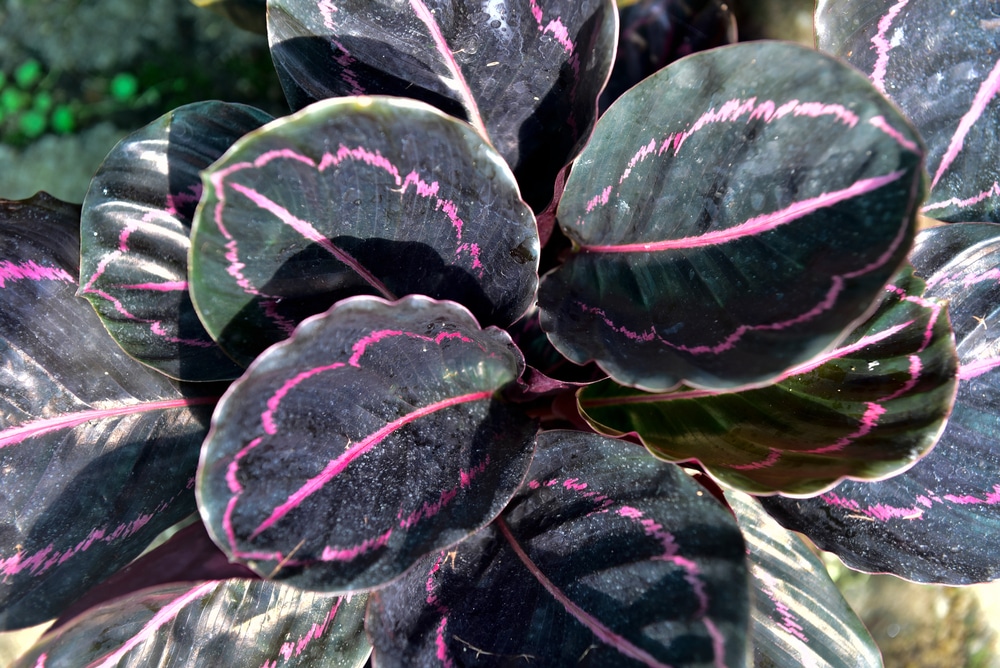
| Origin | Central and South America; Africa |
| Plant size | Grows to about 32 inches (80 centimeters) tall and wide |
| Flowering | Rarely flowers |
| Light | Medium to low light. Avoid direct sun |
| Watering | Keep soil evenly moist but not soggy. Allow the top inch (2.5 centimeters) of soil to dry out between waterings. Drain excess water from plant saucer after watering |
| Fertilizer | Apply balanced fertilizer once a week in spring and summer |
| Potting soil | General purpose potting soil with a bit of added perlite for drainage |
| Pruning | Remove dry or yellowing leaves. Cut off at the base near the main stem |
| Repotting | Repot in spring into a pot 1 inch (2.5 centimeters) bigger in diameter. Use a container that’s wider than deep. |
| Toxicity | Considered non-toxic to pets and people |
Calathea plants get their common name “Prayer plant” from the habit the leaves have to curl up and close their leaves upright in response to low light conditions at night.
‘Purple rose’ is an upright variety with large oval leaves of a rich purple-pink with dark purple edges and undersides. It is a compact bush plant good for small spaces.
Calathea is sensitive to the minerals often found in tap water, which can cause rootburn. Use room temperature rainwater or melted snow if you can.
Being from the tropics, the Prayer plant likes high humidity. They make a great choice for humid bathrooms that get a little sunlight.
Mist the foliage at least once a week, especially in winter. Or sit the plant pot in a saucer of pebbles and water, with the pot over – not in – the water.
Prayer plant also enjoys the occasional sponge bath. Clean the leaves with a damp sponge and room temperature water.
11 – Elephant Ears ‘Black Magic’ or Taro (Colocasia esculenta ‘Black Magic’)
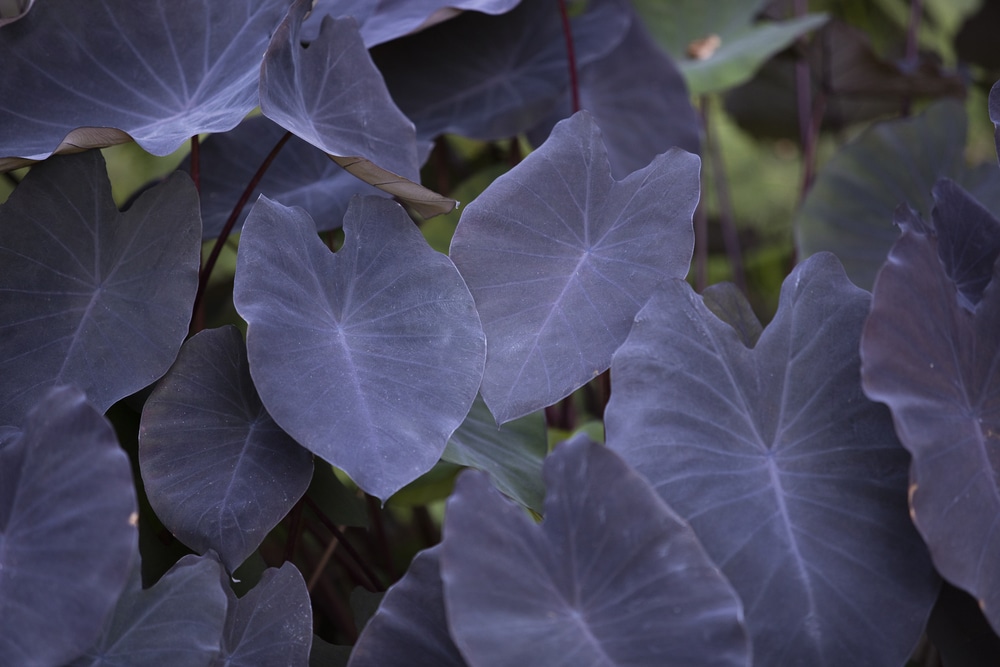
| Origin | Tropical regions of Eastern Asia |
| Plant size | 2 – 4 feet (60 – 120 centimeters) as an indoor plant (sometimes more) |
| Flowering | Rarely flowers |
| Light | Bright light. Filtered – but not direct – sun. Will tolerate low light conditions but color is more intense in brighter light |
| Watering | Keep soil evenly moist but not soggy. Don’t let the soil dry out completely between waterings. In winter allow the soil to dry out slightly |
| Fertilizer | Apply a balanced fertilizer every two weeks in summer. Do not fertilize in winter |
| Potting soil | Rich well-draining potting soil blended for tropical plants. Regular potting soil with added compost. |
| Pruning | Cut off any dead leaves at the base of the plant |
| Repotting | Repot when the plant has doubled in size. Every two years thereafter |
| Toxicity | Toxic to humans and pets if ingested. Sap may cause skin irritation |
There are different varieties of Elephant Ears with leaves in shades of green to purple. One with striking purple leaves is ‘Black Magic’.
The tall thick stems each hold a single large heart-shaped leaf. Both the stems and leaves are a smokey deep almost-black purple.
These plants make quite the statement in home design and grow quite large. They are fast-growing. Be prepared to give them a lot of space. The bigger the pot you give them, the bigger they’ll grow!
Caution: You might find information about taro being edible. In their native regions (and possibly specialty markets in other countries) the tubers may be found for sale at local markets. Portions of the plant are edible BUT ONLY when they have been cooked, which breaks down the harmful oxalic acid.
12 – Hawaiian Ti Plant (Cordyline fruticosa)
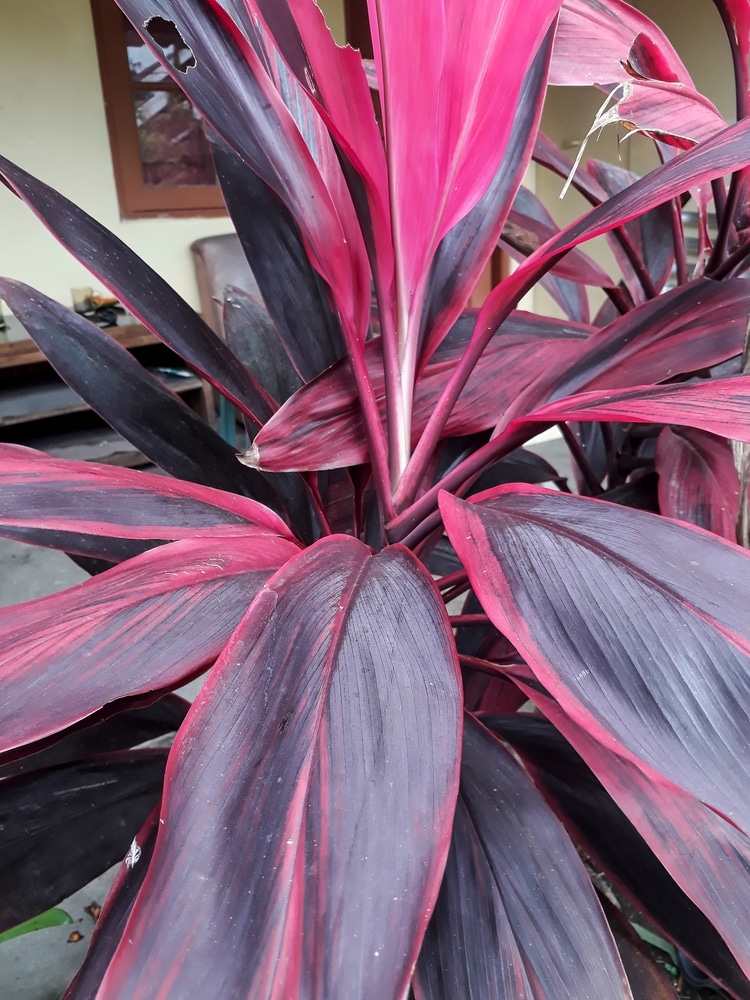
| Origin | Asia; Pacific islands |
| Plant size | 2-10 feet (60-300 centimeters) tall and 3-4 feet wide (90-120 centimeters) |
| Flowering | Rarely flowers indoors |
| Light | Bright indirect light. Can tolerate some direct sun |
| Watering | Water when the top 2 inches (5 centimeters) of soil feels dry. Water a bit at a time until water runs out the pot’s drainage holes. Remove excess water from plant’s saucer |
| Fertilizer | Apply balanced fertilizer weekly in summer. Do not fertilize in winter |
| Potting soil | Rich well-draining potting mix |
| Pruning | None necessary. Cut off dead leaves at base where they attach to main stalk of the plant |
| Repotting | Repot when the plant has crowded its pot (about every 3 years). Use a pot tall enough to hold long taproot |
| Toxicity | Toxic to dogs, considered non-toxic to cats and people. |
Ti plants come in a variety of colors, with leaves in shades of green, red, yellow, cream, and purple. They have long spiky leathery leaves that grow up from a central base.
Ti plants like a lot of light. In low light conditions, the leaves will lose their color and be more solid green.
Ti plants are more sensitive than most indoor plants to the fluoride in most municipal drinking water supplies. Dilute tap water with rain water or distilled water. Too much fluoride may result in the leaf edges going brown and crispy. Eventually the whole leaf may turn brown.
Caution: The leaves of cordyline plants have sharp edges and can cause cuts like paper cuts. So it’s best to place these plants out of reach of children and not in high-traffic areas like hallways or beside a favorite chair.
13 – Bloodleaf Plant, Beefsteak Plant (Iresine herbstii ‘Brilliantissima’)
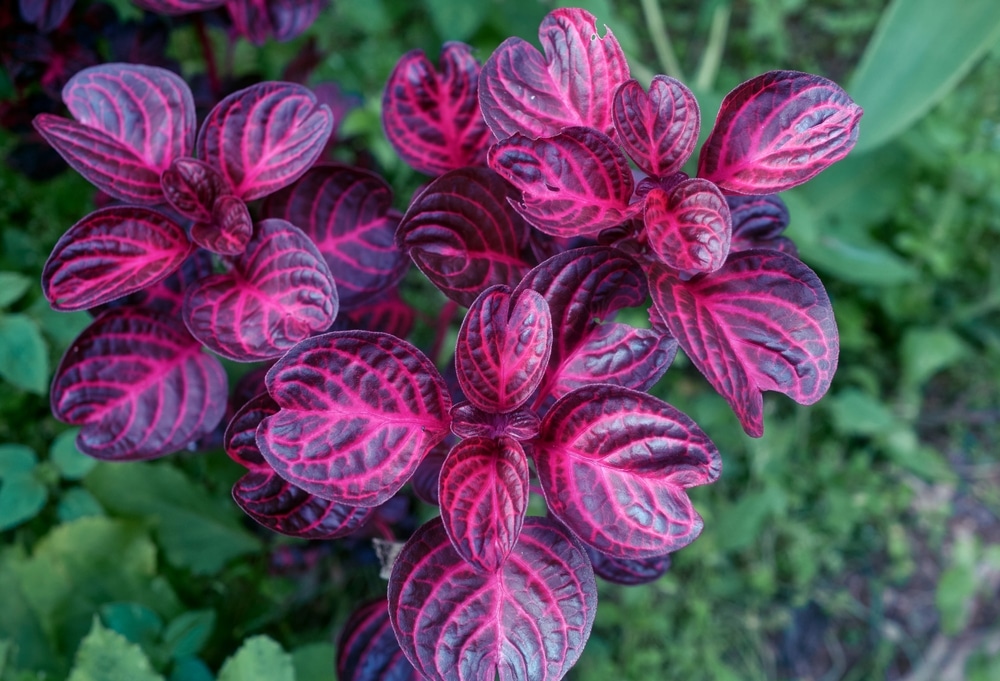
| Origin | South America |
| Plant size | 12-18 inches (30-45 centimeters) tall and wide |
| Flowering | Rarely blooms when grown indoors |
| Light | Bright indirect light. Avoid direct sun |
| Watering | Keep soil evenly moist but not soggy |
| Fertilizer | Apply high nitrogen fertilizer once a month spring through fall. Do not fertilize in winter |
| Potting soil | General-purpose potting mix |
| Pruning | Regularly pinch back growing shoots to encourage side growth for bushier plants |
| Repotting | Every year to two years |
| Toxicity | Highly toxic to humans when eaten. May cause serious skin irritation. Non-toxic to pets |
Bloodleaf is a bright showy plant. It has 4 inch (5 centimeters) long oval-shaped leaves coloured deep purple with bright fuchsia-pink veins. They are a fast-growing plant and may need regular pinching-back of tall stems to encourage shorter bushier growth.
Bloodleaf plants grown indoors rarely flower. If they do, the flowers are small white to pale green flowers and aren’t very showy. They’re usually pinched off to focus the plant’s energy on growing its fabulous foliage.
14 – Purple waffle plant (Hemigraphis colorata)
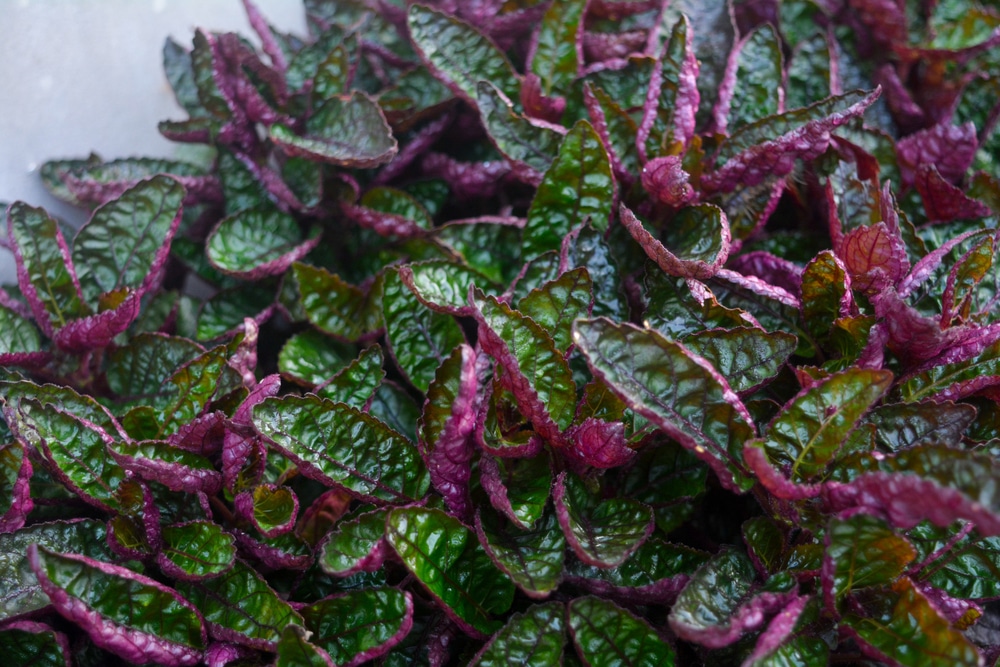
| Origin | Java |
| Plant size | Up to 10 inches (25 centimeters) tall and 8 inches (10 centimeters) wide |
| Flowering | In spring. Insignificant |
| Light | Bright indirect light. Avoid direct sun |
| Watering | Keep soil evenly moist but not soggy. Drain excess water from plant saucer after watering |
| Fertilizer | Apply balanced fertilizer once a month spring through fall, diluted to half the recommended concentration. Do not fertilize in winter |
| Potting soil | General-purpose potting soil |
| Pruning | Generally not necessary. If plants get too scraggly-looking, pinch off the growing tips just above a leaf to encourage bushier side growth |
| Repotting | When roots poke out of pot’s drain holes, repot in spring |
| Toxicity | Non-toxic to humans and pets |
Purple waffle plants have 2-4 inch (5-10 centimeters) long leaves that are deeply textured and crinkly. They’re dark green, almost black on top and the undersides are dark purple.
They produce small stems of small white flowers in spring. These are usually pinched off. The star of the show for this plant is the foliage.
They are an easy-to-grow low maintenance plant for adding color to the home decor. Their small size also makes them a good choice for the office.
Give them enough light to maintain their purple coloring, it fades to dark green in low light conditions.
They enjoy high humidity and benefit from a daily misting, especially in winter. Or, place the pot on a tray of pebbles and water, with the plant pot sitting over – not in – the water.
Purple waffle plant can be a bit of a drama queen if it misses a watering! Its leaves will wilt heavily. Don’t worry, though, with a thorough watering they will soon bounce back and the plant will revive nicely.
15 – Burgundy Rubber Tree (Ficus elastica ‘Burgundy’)
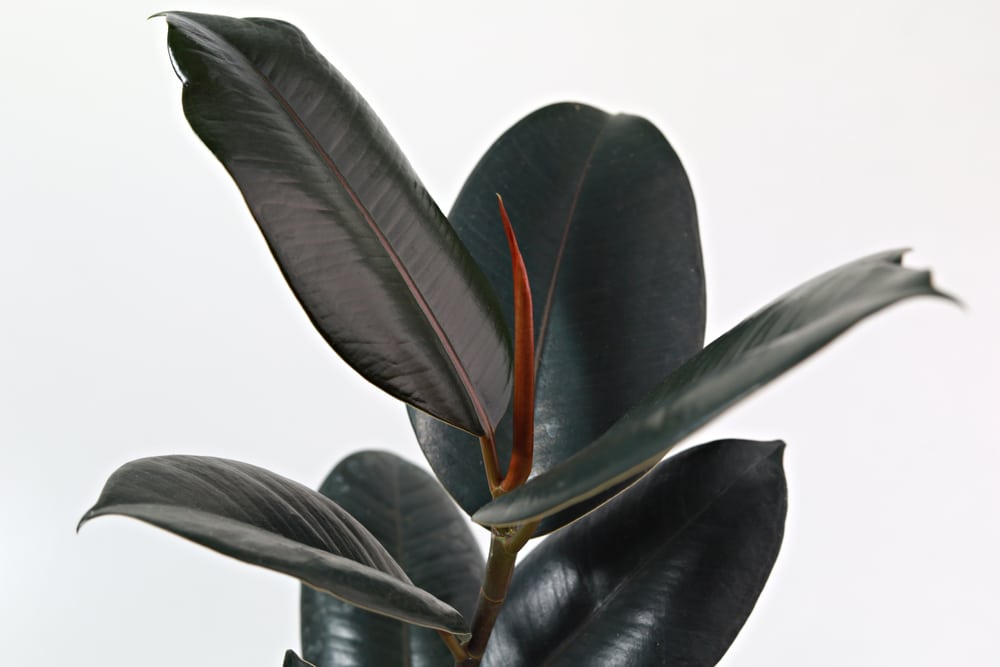
| Origin | Southeast Asia; India |
| Plant size | Up to 10 feet (304.8 centimeters) tall |
| Flowering | n/a |
| Light | Bright indirect sun. Can tolerate low light |
| Watering | Allow soil to dry out between waterings. Then water slowly and thoroughly |
| Fertilizer | Apply fertilizer with slightly higher nitrogen once a month. Do not fertilize in winter |
| Potting soil | General-purpose potting soil with added perlite for good drainage |
| Pruning | None necessary but can be pruned to encourage bushier growth |
| Repotting | Repot when roots show out the pot’s drainage holes, or about every two years |
| Toxicity | Mildly toxic to pets and humans if ingested. Sap is a skin irritant |
The Burgundy rubber tree is commanding with large glossy leaves that change from deep burgundy to dark green as they grow and uncurl.
This plant can grow quite tall and should be given lots of space. They make quite a statement in home decor.
It is a very low-maintenance plant, needing minimal watering. It is tolerant of low light conditions but its purple coloring will be more intense with more light.
Rubber trees will benefit from occasionally cleaning the leaves with a damp cloth to remove dust and maintain their glossy sheen.
CAUTION: All ficus plants have a milky sap that can be a skin irritant. When pruning or repotting, it is a good idea to wear gloves. This sap also makes the plants dangerous for pets to chew or ingest.
Sources:
Courtier, Jane & Clark, Graham. Indoor Houseplants: The Essential Guide to Choosing and Caring for Houseplants. Reader’s Digest, 1997.

